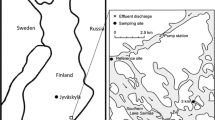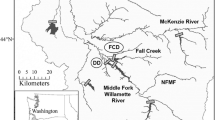Abstract
Cutthroat trout (Salmo clarki) were exposed for 90 days in the laboratory to a refined oil collected from the North Platte River at a seepage site below the American Oil Company refinery at Casper, Wyoming. Fish were exposed to five concentrations and a control, and seven biological responses (survival, growth, gill pathology, liver pathology, caudal fin erosion, caudal fin pathology and swimming performance) were correlated with water concentration and tissue accumulation of petroleum hydrocarbons. Fish in the highest water concentration, 183μg/L total oil, accumulated tissue concentrations of 4.6μg/g total naphthalenes and responded adversely to all seven biological measurements. Cutthroat trout in the lowest water concentration, 24μg/L total oil, had a mean tissue concentration of 1.2μg/g total naphthalenes, but their response was similar to that of the control fish to all seven biological responses. Fish exposed to 39μg/L water concentration accumulated tissue concentrations of 2.7μg/g and responded negatively to 2 of the 7 biological measurements. Therefore, the maximum safe limit for this oil and cutthroat trout is between 24 and 39μg/L.
Similar content being viewed by others
References
Anderson, J. W.: Responses to sublethal levels of petroleum hydrocarbons: Are they sensitive indicators and do they correlate with tissue contamination? In D. A. Wolfe (ed.): Fate and effects of petroleum hydrocarbons in marine ecosystems and organisms, p. 95. New York: Pergamon Press (1977).
—: An assessment of knowledge concerning the fate and effects of petroleum hydrocarbons in the marine environment. In W. B. Vernberg, A. Calabrese, F. P. Thurberg, and F. J. Vernberg (eds.): Marine pollution: Functional responses. p. 3. New York: Academic Press (1979).
Anderson, J. W., J. M. Neff, B. A. Cox, H. E. Tatem, and G. M. Hightower: Characteristics of dispersions and water-soluble extracts of crude and refined oils and their toxicity to estuarine crustaceans and fish. Mar. Biol.27, 75 (1974).
Connell, D. W., and G. J. Miller: Petroleum hydrocarbons in aquatic ecosystems-behavior and effects of sublethal concentrations. Crit. Rev. Environ. Cont.11, 37 (1980).
Giles, R. C., L. R. Brown, and C. D. Minchew: Bacteriological aspects of fin erosion in mullet exposed to crude oil. J. Biol.13, 113 (1978).
Hawkes, J.: Effects of petroleum hydrocarbon exposure on structure of fish tissue. In D. Wolfe (ed.): Fate and effects of petroleum hydrocarbons in marine organisms and ecosystems. p. 115. New York: Pergamon Press (1977).
Junk, G. A., J. J. Richard, M. D. Brieser, D. Witiak, J. L. Witiak, M. D. Arguello, R. Vick, H. J. Svec, J. S. Fritz, and G. B. Caulder: Use of macroreticular resins in the analysis of water for trace organic contaminants. J. Chromatogr.99, 745 (1974).
Malins, D. C.: Biotransformation of petroleum hydrocarbons in marine organisms indigenous to the arctic and subarctic. In D. Wolfe (ed.): Fate and effects of petroleum hydrocarbons in marine organisms and ecosystems. p. 47, New York: Pergamon Press (1977).
Martin, H. W.: A method of measuring lengths of juvenile salmon from photographs. Prog. Fish Cult.29, 238 (1967).
McAuliffe, C. D.: GC determination of solvents by multiple-phase equilibration. Chem. Technol.1, 46 (1971).
Minchew, D. D., and J. D. Yarbrough: The occurrence of fin rot in mullet (Mugil cephalus) associated with crude oil contamination of an estuarine pond-ecosystem. J. Fish Biol.10, 319 (1977).
Moles, A., S. Bates, S. D. Rice, and S. Korn: Reduced growth of coho salmon fry exposed to two petroleum compounds, toluene and naphthalene, in fresh water. Trans. Amer. Fish. Soc.110, 430 (1981).
Moles, A., S. D. Rice, and S. Korn: Sensitivity of Alaskan freshwater and anadromous fishes to Prudhoe Bay crude oil and benzene. Trans. Amer. Fish. Soc.108, 408 (1979).
Mount, D. I., and W. A. Brungs: A simplified dosing apparatus for fish toxicology studies. Water Res.1, 21 (1967).
Neff, J. M., D. Dixit, B. A. Cox, and J. W. Anderson: Accumulation and release of petroleum derived aromatic hydrocarbons by four species of marine animals. Mar. Biol.38, 278 (1976).
Nuwayhid, M. A., P. S. Davies, and H. Y. Eldes: Changes in the ultrastructure of the gill epithelium ofPatella vulgata after exposure to North Sea crude oil and dispersants. J. Mar. Biol. Assoc. United Kingdom60, 439 (1980).
Rice, S. D., J. W. Short, and J. F. Karinen: Comparative oil toxicity and comparative animal sensitivity. In D. A. Wolfe (ed.): Fate and effects of petroleum hydrocarbons in marine ecosystems and organisms. p. 78. New York: Pergamon Press (1977).
Roubal, W. T., S. I. Stronahan, and D. C. Malins: The accumulation of low molecular weight aromatic hydrocarbons of crude oil by coho salmon (Oncorhynchus kisutch) and starry flounder (Platichthys stellatus). Arch. Environ. Contam. Toxicol.7, 237 (1978).
Shaw, D. G., L. E. Clement, D. J. McIntosh, and M. S. Stekoll: Some effects of petroleum on nearshore Alaskan marine organisms. EPA-600/53-81-018. Corvallis, OR: U.S. Environmental Protection Agency (1981).
Simard, R. G., I. Hasegawa, W. Bandurak, and C. E. Headington: Infrared spectrophotometric determination of oil and phenols in water. Anal. Chem.23, 1384 (1952).
Snedecor, G. W.: Statistical methods. Ames, IA: Iowa State University Press (1965).
Varanasi, U., D. J. Gmus, and W. L. Reichert: Effect of environmental temperature on naphthalene metabolism by juvenile starry flounder (Platichthys stellatus). Arch. Environ. Contam. Toxicol.10, 203 (1981).
Varanasi, U., and D. C. Malins: Metabolism of petroleum hydrocarbons: Accumulation and biotransformation in marine organisms. In D. C. Malins (ed.): Effects of petroleum on arctic and subarctic marine environments and organisms, Vol. II, p. 175. New York: Academic Press (1977).
Warner, J. S.: Determination of aliphatic and aromatic hydrocarbons in marine organisms. Anal. Chem.48, 578 (1976).
Woodward, D. F., P. M. Mehrle, Jr., and W. L. Mauck: Accumulation and sublethal effects of a Wyoming crude oil in cutthroat trout. Trans. Amer. Fish. Soc.110, 437 (1981).
Author information
Authors and Affiliations
Rights and permissions
About this article
Cite this article
Woodward, D.F., Riley, R.G. & Smith, C.E. Accumulation, sublethal effects, and safe concentration of a refined oil as evaluated with cutthroat trout. Arch. Environ. Contam. Toxicol. 12, 455–464 (1983). https://doi.org/10.1007/BF01057589
Received:
Revised:
Issue Date:
DOI: https://doi.org/10.1007/BF01057589




